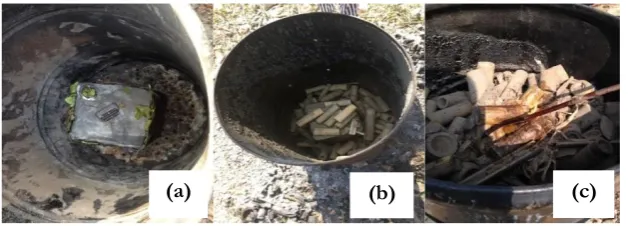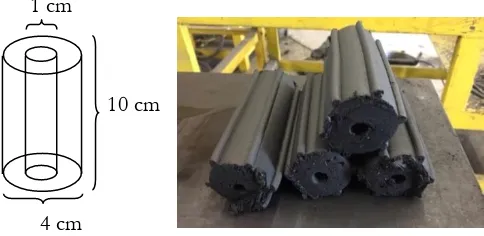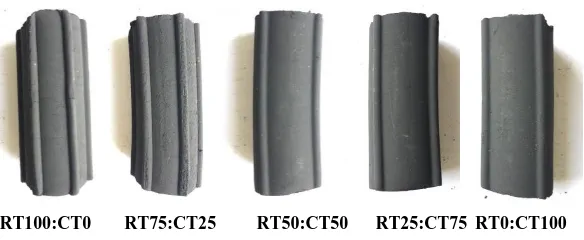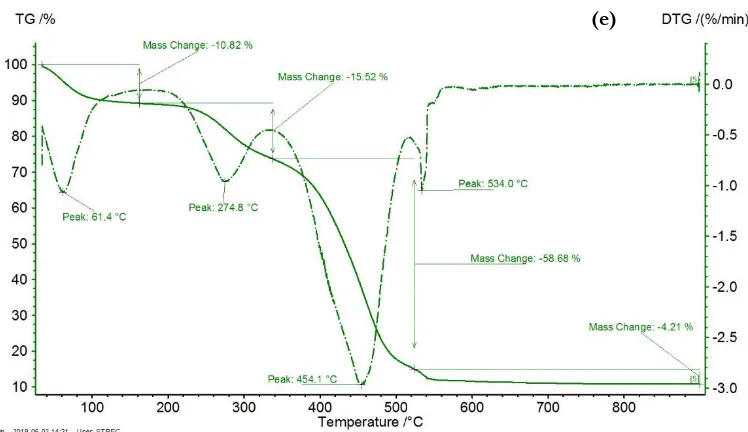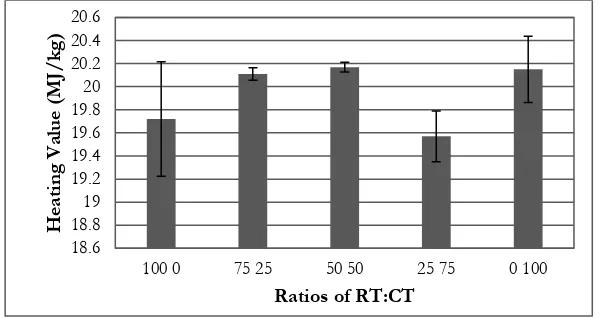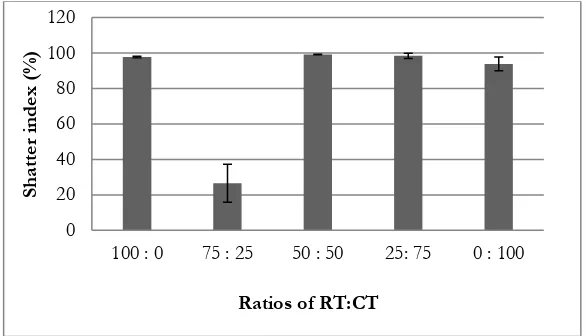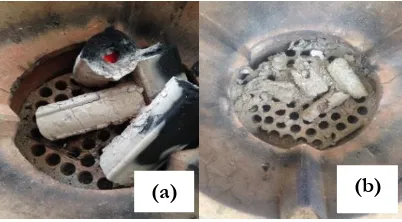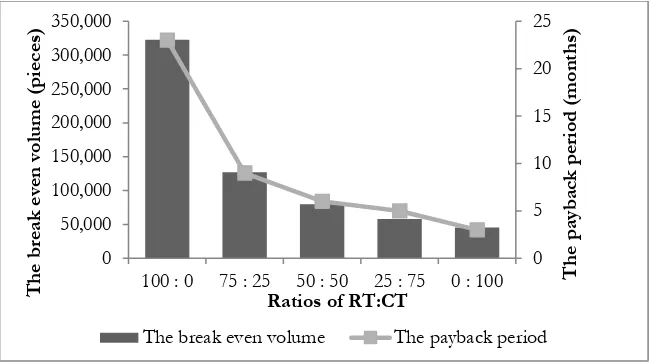Article
Carbonized Briquettes as a Tool for Adding Value to
Waste from Rain tree (
Samanea Saman
) and Coffee
Ground/Tea Waste
Nattakarn Kansai
a, Nichakorn Chaisuwan
band Nuta Supakata
c,*Department of Environmental Science, Faculty of Science, Chulalongkorn University, Bangkok 10330, Thailand
E-mail: ayung_ZzAa@hotmail.com, btonii.nachi_nicha@hotmail.com, cnuta.s@chula.ac.th (Corresponding author)
Abstract. The purpose of this research was to study the physical and economic characteristics of carbonized briquettes from rain tree (Samanea saman) residues and coffee ground/tea waste with cassava starch (10% wt.). This experiment utilized five treatments. As a binder, 10% wt. cassava starch was added to five ratios of rain tree residues to coffee ground/tea waste: RT100:CT0, RT75:CT25, RT50:CT50, RT25:CT75, and RT0:CT100. The physical properties of the carbonized briquettes were analyzed using ASTM methods. The results showed that carbonized briquettes made from 50% rain tree (Samanea saman) residues and 50% coffee ground/tea waste (RT50:CT50) had the highest calorific value (20.17 ± 0.042 MJ/kg)—insignificant at the 95% confidence interval—and highest shatter index (99.16 ± 0.20%). However, all ratios of rain tree residues to coffee ground/tea waste can produce carbonized briquettes for household use, convenient for transportation. In terms of economic performance, carbonized briquettes made from 50% rain tree (Samanea saman) residues and 50% coffee ground/tea waste (RT50:CT50) achieved the optimal payback period (approximately six months). Thus, making carbonized briquettes from rain tree residues and coffee ground/tea waste a viable alternative method of adding value to biomass residue for use as raw materials to produce fuel products for household cooking.
Keywords: Carbonized briquette, rain tree (Samanea Saman), coffee ground/tea waste.
ENGINEERING JOURNAL Volume 22 Issue 6 Received 6 June 2018
1.
Introduction
Thailand’s final energy consumption in 2016 was 79,929ktoe, an increase of 2.6% from 2015, with a total final energy consumption value of 868,105 million baht [1]. The country has also been showing a tendency toward an increase in energy consumption of up to 30% by the year 2021 [2]. Approximately 80% of the total final energy consumption in 2016 was from commercial industries, including petroleum and fossil fuels, electricity, coal, and natural gas, of which, oil and coal are mainly imported. Due to the dependency on imports, the Thai government’s goal is to increase the country’s ratio of renewable energies to 30% total consumption by 2036. One energy alternative is biomass, a carbon-based energy with abundant availability [3]. Biomass can be obtained from various sources, including agricultural crops, agriculture residues, wood and wood residues, industrial sludge, and municipal solid waste. However, biomass has a high moisture content and poor ignitability, so briquette technology will provide an alternative solution to improving biomass quality.
The briquette technology is a process of compacting loose biomass to form a compacted and shaped product. According to the Thai Community Product Standard (TCPS), the briquette’s appealing characteristics include its heating value (> 20.92 MJ/kg), moisture content (< 8%), and lack of smoke and scent when ignited by fire [4]. The briquetting process can be classified into two types: hot and cold compression, as a briquette cannot be molded into shape without adding a binding material [5].
Briquette fuel usually has a low density, leading to loss of strength. To solve this problem, cassava starch will be used as a binder. A study by Sotannde, Oluyege, and Abah [6] showed that the quality of a briquette bonded with cassava starch was durable and its density was higher than a briquette bonded with gum arabic. Moreover, cassava starch has the best combustion and physical properties, particularly its heating value, ash content, volatile matter, and fixed carbon content when compared to briquettes bonded with cow dung, wood ash [7], and gum arabic [8]. Furthermore, cassava starch has a low cost and it is purchased easily from markets or grocery stores [6]. In addition, the organic matter in briquettes may contain moisture, thus causing the briquettes to have a lower heating value. If this is the case, the carbonization process will be applied, to increase the fixed carbon and heating value [9]. Additionally, this process has been proven to remove the moisture content and volatile matter from the briquettes [10]. Carbonization, conducted in the absence or inadequate presence of oxygen, to produce a high heating value fuel that can eliminate volatile matter, is a promising technology for biomass production [11].
Many studies have shown that biomass, such as cabbage market waste [12], coconut shells [13], sugar cane [14], rice straw [15], algae [16], paper waste [17], coffee grounds [18], and the like, can be used as raw materials for briquette production. Coffee grounds are a biomass material with a high heating value of 25.26 MJ/kg [18].
As tea and coffee are popular drinks today, the number of coffee shops in Thailand has increased by 5.4% annually in the past five years [19]. At Chulalongkorn University, there are 20 shops (each with four coffee brands), and each shop produces approximately15–20 kg/day of coffee ground/tea waste residues, all of which are collected and disposed of in landfills. The cost of the solid waste management of these landfills is approximately 250–300 baht/ton of solid waste [20].
Furthermore, Thailand has many perennial plants that are potential sources of carbonized briquette production. Chulalongkorn University is one of the universities in Thailand that is home to the prominent perennial plant named the rain tree (Samanea saman). Rain trees are large—over25 meters tall—and can live for up to 100 years [21]. These large trees shed leaves on Chulalongkorn University’s campus all year long, and their leaves and branches are considered waste. The rain tree’s leaves have a moisture content of 47.78% and ash content of 1.95% [22]. To add value to these waste materials, rain tree residues and coffee ground/tea waste were used to produce the carbonized briquettes in this study. The method for carbonized briquette production can be divided into two steps: carbonization and briquetting, which can improve the fixed carbon content [23].
2.
Materials and Methods
2.1. Materials
In this study, 150 kg of rain tree (Samanea saman) residues were obtained from Physical Resources Management, Chulalongkorn University, and 125 kg of coffee ground and tea waste were collected from coffee shops in Chulalongkorn University. Before using the biomass, rain tree residues and coffee ground/tea waste were air-dried using solar heat (Fig. 1).
Fig. 1. (a) Rain tree residues; (b) Coffee ground/tea waste.
[image:3.595.173.428.190.296.2]The proximate and elemental methods of analyzing rain tree residues and coffee ground/tea waste used herein are shown in Table 1.
Table 1. Proximate and elemental analytical methods.
Physical properties Instrument/Method
Proximate analysis Heating Values
Moisture content ASTM D 5865 [24] ASTM D 3173 [25] Volatile matter ASTM D 3175 [26]
Ash Content ASTM D 3174 [27]
Fixed carbon
Elemental analysis ASTM D 3172 [28]
C H N S Elemental Analyzer (Leco, Germany)
2.2. Methods of Producing Carbonized Briquettes
2.2.1. To produce carbonized biomass, rain tree residues and coffee ground/tea waste with a moisture content of less than 25% obtained from 2.1 were carbonized at a temperature of 550oC in 200-L tanks for 24 h, as shown in Fig. 2.
Fig. 2. (a) Raw materials were packed in a 10-L bucket; (b) The 10-L bucket with raw materials was put in a 200-L tank; (c) Bamboo was filled in the 200-L tank as fuel, and it was fired using diesel oil.
When fire was dispersed among all the 200-L tanks, all tanks were closed (Fig. 3).
(a) (b)
(b) (c)
[image:3.595.111.485.391.514.2] [image:3.595.142.457.598.711.2]Fig. 3. (a) Fire was dispersed among all the 200-L tanks; (b) Raw materials were carbonized in the closed 200-L tanks for 24 h.
After carbonization was completed, raw materials were cooled down in a 200-L tank for 24 h. The carbonized materials gained from this process are shown in Fig. 4.
Fig. 4. (a) Carbonized rain tree residues; (b) Carbonized coffee ground/tea waste.
2.2.2. In the process of briquetting, carbonized rain tree residues and carbonized coffee ground/tea waste were mixed (Fig. 5) into five homogeneous texture ratios of RT100:CT0, RT75:CT25, RT50:CT50, RT25:CT75, and RT0:CT100, with 10% wt. cassava starch as a binder (Table 2).
Fig. 5. The mixtures of materials in the mixing machine.
Fig. 6. Size and shape of carbonized briquette.
(a) (b)
(a) (b)
1 cm
10 cm
[image:4.595.191.406.89.198.2] [image:4.595.200.416.284.400.2] [image:4.595.163.433.484.583.2] [image:4.595.176.418.626.744.2]Table 2. The ratios of carbonized rain tree residues, carbonized coffee ground/tea waste, and cassava starch
Ratios of rain tree residues:coffee ground-tea waste (RT:CT)
Carbonized rain tree residue
(kg) Carbonized coffee ground-tea waste (kg)
Cassava starch (kg)
100 : 0 10.00 (100%) 0.00 (0%) 1.00
75 : 25 7.50 (75%) 2.50 (25%) 1.00
50 : 50 5.00 (50%) 5.00 (50%) 1.00
25 : 75 2.50 (25%) 7.50 (75%) 1.00
0 : 100 0.00 (0%) 10.00 (100%) 1.00
However, the moisture of the materials in the mixing machine was approximately 20% by adding tap water, where the volume of tap water was below the moisture of the materials. The mixtures were formed in cylinder shapes with an inner diameter of 1 cm, an outer diameter of 4 cm, and a length of 10 cm (Fig. 6) using a briquetting machine (5.5 kW). Then, carbonized briquettes were air-dried using solar heat for 5 days.
2.3. Characterization of Carbonized Briquettes from Rain Tree Residues and Coffee Ground/Tea Waste
The physical and chemical characteristics of carbonized briquettes were estimated according to TCPS following the American Society for Testing and Materials (ASTM) method, including heating value, moisture content, volatile matter, ash content, and fixed carbon, as shown in Table 1. In addition, the compressive strength, shatter index, time of boil, and burning time were analyzed (Table 3).
Table 3. Additional physical properties of carbonized briquettes.
Physical properties Instrument/Method
Compressive strength
The samples of carbonized briquettes were tested using the Amsler 20 tons machine at the Faculty of Engineering, Chulalongkorn University.
Shatter index Each sample was dropped from a consistent height (1.5 m) onto a concrete floor, and weight loss was documented [16].
Time of boil
Two liters of water was boiled using cook stoves with carbonized briquettes (150 g). The stopwatch was started when the briquettes were fully ignited and ended when the water temperatures remained constant for 10 s [29].
Burning time Burning time is the total time taken for the fuel to completely burn to ashes [29].
2.4. Economic Feasibility
An economics analysis of the production of carbonized briquettes from rain tree residues and coffee ground/tea waste was conducted using the following Eq. (1) and (2).
The break-even volume (N*)
N ∗ = 𝐹
𝑃−𝑉 , (1)
[image:5.595.67.529.128.251.2] [image:5.595.70.524.452.623.2]N* is the break-even volume F is the fixed cost, USD
P is the price per unit, USD/unit V is the variable cost, USD.
The payback period
Payback period =𝑁∗𝑁 , (2)
where
N* is the break-even volume N is the productivity yield/year
A fixed cost is a cost that does not vary in the short term with an increase or decrease in the amount of goods produced or sold. In this study, fixed costs are machine costs from the briquetting machine.
A variable cost is an expense that varies with the production output. In this study, variable costs are raw material capital (cassava starch), 200-L tanks, buckets, transportation capital, human labor, and electricity.
The data for fixed cost and variable cost are shown in Table 4.
Table 4. Data of fixed cost and variable cost.
Type Cost Source
Raw
materials Rain tree residues Coffee ground - tea waste Cassava starch
0 USD/kg 0 USD/kg 0.55 USD/kg
Chulalongkorn University Chulalongkorn university Bakery shop
Machine and equipment
Mixing Machine Fabrication Machine tanks200 litters
944.82 USD/unit 944.82 USD/unit 27.43 USD/unit
Bongwang kasetyon, Suphanburi Bongwang kasetyon, Suphanburi Fuels and Energy from Biomass center, Chulalongkorn University, Saraburi
3.
Results and Discussion
3.1. Characterization of Raw Materials
The ultimate analysis of rain tree (Samanea saman) residues and coffee ground/tea waste was conducted using an elemental analyzer (LECO model CHN-628), as shown in Table 5. The results showed that the major component of rain tree residues and coffee ground/tea waste was carbon, while the minor components were oxygen, hydrogen, and nitrogen. Sulfur, a chemical element causing acid rain by the formation of Sulphur dioxide emissions [30], was not found in either.
Table 5. The ultimate analysis of rain tree (Samanea saman) residues and coffee ground/tea waste.
Sample Ultimate analysis
%Carbon %Hydrogen %Nitrogen %Sulfur %Oxygen** Rain tree residues 58.76 ± 0.12 5.23 ± 1.04 3.25 ± 0.23 ND 32.86 ± 0.12 Coffee ground/tea waste 53.94 ± 0.22 6.14 ± 0.75 3.31 ± 0.47 ND 36.65 ± 0.07 *ND : Not detected.
**Oxygen was calculated by difference.
[image:6.595.51.547.344.459.2] [image:6.595.72.519.623.684.2]Table 6. The proximate analysis of rain tree (Samanea saman) residues and coffee ground/tea waste.
Sample Heating value (MJ/kg)
Proximate Analysis Moisture
content (%)
Volatile matter (%)
Ash content (%)
Fixed carbon (%) Rain tree residues 20.49 ± 0.010 8.06 ± 2.01 78.03 ± 0.13 5.09 ± 0.21 8.82 ± 2.34 Coffee ground/tea
waste 17.02 ± 0.001 9.51 ± 0.47 79.15 ± 0.25 2.26 ± 1.32 9.08 ± 2.03
According to Tangmankongworakoon and Preedasuriyachai [31], the heating value of coffee grounds was increased after carbonization from 23.08 MJ/kg to 30.79 MJ/kg, as well as tea waste from 18.77 MJ/kg to 23.43 MJ/kg. Moreover, the fixed carbon of carbonized coffee grounds and tea waste was increased from 19.43% to 77.77% and 18.43% to 65.29% respectively. Thus, the carbonization process increased the fixed carbon of coffee grounds and tea waste which affected the increment of heating value.
3.2. Characteristics of Carbonized Briquettes According to TCPS
Characteristics of carbonized briquettes from rain tree (Samanea saman) residues and coffee ground/tea waste, including general appearance, thermogravimetric analysis (TGA), heating value, moisture content, volatile matter, ash content, and fixed content, were determined according to the TCPS 238-2547 specification.
Figure 7 shows that the general appearance of carbonized briquettes includes an all-black color and smooth surface with four or six fins depending on the molds used in the briquetting process.
Fig. 7. The general appearance of carbonized briquettes.
Figure 8 shows the TGA values of five carbonized briquettes ratios. This thermal decomposition of carbonized briquettes could be divided into three stages. The weight was slightly decreased during the initial drying, due to moisture loss. In the first stage, the amount of moisture was removed during the temperature range of 50-150°C with a sharp peak of dryness at 59-62°C (Rajaseenivasan et al., 2016). The peak of mass loss rate of RT0:CT100 was more than those at RT100:CT0, RT75:CT25, RT50:CT50 and RT25:CT75. The second stage, the temperature range of 190-450°C, with a sharp peak at 260-275°C, and thermal increase of volatility as hemicellulose (190°C–320°C), cellulose (280°C–400◦C), and lignin (320°C–450°C) lost content in carbonized briquettes [32]. The peak of mass loss in this stage rate of RT0:CT100 was more than those at RT100:CT0, RT75:CT25, RT50:CT50 and RT25:CT75. In the third stage, the temperature ranges from 350°C–550°C corresponded to the carbon burning in the carbonized briquettes [33], and ash content was lost in this stage [34].
[image:7.595.67.529.106.195.2] [image:7.595.153.445.398.518.2](a)
(c)
Fig. 8. TGA results for carbonized briquettes from rain tree (Samanea saman) residues and coffee ground/tea waste (a) with the ratio RT100:CT0, (b) with the ratio RT75:CT25, (c) with the ratio RT50:CT50, (d) with the ratio 25:75, and (e) with the ratio RT0:CT100.
The moisture content was found to be significantly different (P<0.001) in each carbonized briquette ratio at the 95% confidence interval. The range of moisture content was below 8% [4] in all ratios except RT0:CT100, carbonized briquettes composed from 100% coffee ground/tea waste. A low moisture content improves the quality of carbonized briquettes (earlier ignition) [35], as shown in Fig. 9.
Fig. 9. Moisture content of carbonized briquettes.
As shown in Table 7, the physical properties of the carbonized briquettes, including volatile matter, ash content, and fixed carbon, were in the range of 27 to 37%, 14 to 33%, and 31 to 39%, respectively. High volatile matter results in easing ignition and enhancing combustion [32]. Conversely, high ash content decreases the heating value and increases the thermal resistance to heat transfer [32, 36-38].
0 2 4 6 8 10 12
100 : 0 75 : 25 50 : 50 25: 75 0 : 100
Mo
is
tur
e
conten
t
(%)
Ratios of RT:CT
[image:10.595.113.487.80.296.2] [image:10.595.149.447.439.627.2]Table 7. The results of physical properties of carbonized briquettes including volatile matter, ash content, and fixed carbon.
Ratios of rain tree residues:coffee ground-tea waste (RT:CT)
Volatile matter (%)
Ash content
(%) Fixed carbon (%)
100 : 0 27.84 ± 2.16 33.04 ± 2.32 31.76 ± 3.99 75 : 25 34.34 ± 0.34 22.75 ± 0.86 32.19 ± 0.68 50 : 50 33.12 ± 0.70 19.06 ± 0.47 37.13 ± 0.49 25 : 75 35.18 ± 0.21 16.19 ± 4.38 37.48 ± 2.17 0 : 100 37.30 ± 0.52 14.51 ± 4.79 38.68 ± 2.39
[image:11.595.125.472.117.218.2]The heating values of all ratios were found to be in the range of 19.57-20.17 MJ/kg, as shown in Fig. 10. However, the heating values of carbonized briquettes were nearly the standard value of 20.92 MJ/kg [4]. None of the carbonized briquette ratios showed a significant difference in heating values, with approximate P-values of 0.233 at the 95% confidence interval. This implied that all carbonized briquette ratios have the potential for use as household cooking fuel [35] and the heating value depends on the composition of materials in carbonized briquettes [39].
Fig. 10. Heating value of carbonized briquettes.
3.3. The Characteristics of Carbonized Briquettes for Transportation, Storage, and Utilization in Household Cooking
Compressive strength of the briquettes indicated its capability to be handled and transported without breaking [40]. The range of compressive strength across all carbonized briquette ratios was 0.97–2.57 MPa, as shown in Fig. 11. The compressive strength of the carbonized briquettes with the ratios RT100:CT0, RT50:CT50, and RT25:CT75 were not significantly different, and they were higher than the ratios of RT75:CT25 and RT0:CT100. However, the compressive strength of a carbonized briquette depends on the bonding forces that bind the materials together [41].
18.6 18.8 19 19.2 19.4 19.6 19.8 20 20.2 20.4 20.6
100 0 75 25 50 50 25 75 0 100
H
ea
ti
ng
Val
ue
(
MJ/kg)
[image:11.595.148.449.317.476.2]Fig. 11. Compressive strength of carbonized briquettes.
The strength of carbonized briquettes can be confirmed by the shatter index [34], which indicates convenience in terms of transportation, handling and utilization for consumers [16]. The shatter index results of all carbonized briquette ratios (RT100:CT0, RT75:CT25, RT50:CT50, RT25:CT75, and CT0:CT100) were 97.71 ± 0.46%, 26.58 ± 10.72%, 99.16 ± 0.20%, 98.40 ± 1.44%, and 93.84 ± 3.92%, respectively, as shown in Fig. 12. The shatter index showed significant differences with a P-value less than 0.001 at the 95% confidence interval for all ratios of carbonized briquettes. In this study, the ratio of RT50:CT50 had the highest shatter index due to its higher binding capacity. This result implied that the carbonized briquette ratio of RT50:CT50 was hard to disintegrate [34] and was resistant to handling stress, especially in transportation [42].
Fig. 12. Shatter indexes of carbonized briquettes.
To obtain the practical results for the performance of the carbonized briquettes, time of boil and burning time tests were conducted in an open-air environment. The tests were performed using a stove to boil water in a cooking pot [43]. This is very important, because, in local areas of Thailand, domestic cooking is usually carried out in the open. The time of boil and burning time results are shown in Fig. 13. Time of boil (Fig. 14) did not show a significant difference in any carbonized briquette ratios, with a P-value of 0.068. This result implied that all carbonized briquette ratios have the potential to boil water and cook food with the same quality in the same period. Approximately 0.5 kg of each carbonized briquette ratio (completely burnt to ash, as shown in Fig. 15) were examined for burning to ash [29]. A statistical analysis showed a significant difference in all carbonized briquette ratios with a P-value less than 0.001 at the 95% confidence interval. The carbonized briquettes from 100% rain tree residues (RT100:CT0) had the
0.0 0.5 1.0 1.5 2.0 2.5 3.0 3.5
100 : 0 75 : 25 50 : 50 25: 75 0 : 100
Co
mpr
es
si
ve
str
en
gth
(MPa)
Ratios of RT:CT
0 20 40 60 80 100 120
100 : 0 75 : 25 50 : 50 25: 75 0 : 100
Sha
tter
ind
ex
(
%)
[image:12.595.151.444.422.590.2]highest burning time (181.67 ± 1.53 min), which implies that the carbonized briquette made from 100% rain tree residues had an efficiency most suited to boil water or to cook food for the longest time.
Fig. 13. Time of boil and burning time of carbonized briquettes.
Fig. 14. (a) A fire is set on the carbonized briquette on a stove; (b) The water temperature is recorded using Extech Infrared Thermometer 42512.
Fig. 15. (a) The carbonized briquettes are fully lit; (b) The carbonized briquette is burned completely to ash.
The heating values of all ratios were in the range of 19.57–-20.17 MJ/kg, which is nearly the TCPS value (20.92 MJ/kg), and the moisture content was below 8% [4] in all ratios except RT0:CT100.
3.4. The Economic Performance of Five Ratios of Carbonized Briquettes Made from Rain Tree Residues and Coffee Ground/Tea Waste and Market Charcoal
To evaluate the economic performances of all ratios of carbonized briquettes, the break-even volume (N*), indicating the number of units sold at which sales revenue equals total costs, and the payback period,
0 20 40 60 80 100 120 140 160 180 200
100 : 0 75 : 25 50 : 50 25: 75 0 : 100
Ti
me
(mi
n)
Ratios of RT:CT
Time of boil Burning time
(b) (a)
[image:13.595.207.411.358.473.2] [image:13.595.193.394.522.633.2]indicating the length of time required to recover the cost of carbonized briquette production, were calculated (Fig.16).
Carbonized briquettes made from 100% rain tree (Samanea saman) residues (RT100:CT0) had a break-even volume of 322,727 pieces and a payback period of 1.87 years, or approximately 1 year and 11 months. Carbonized briquettes made from 75% rain tree (Samanea saman) residues and 25% of coffee ground/tea waste (RT75:CT25) had a break-even volume of 126,786 pieces and a payback period of 0.73 years, or approximately 9 months.
Carbonized briquettes made from 50% rain tree (Samanea saman) residues and 50% coffee ground/tea waste (RT50:CT50) had a break-even volume of 79,775 pieces and a payback period of 0.46 years, or approximately 6 months.
Carbonized briquettes made from 25% rain tree (Samanea saman) residues and 75% coffee ground/tea waste (RT25:CT75) had a break-even volume of 58,197 pieces and a payback period of 0.34 years, or approximately 5 months.
Carbonized briquettes made from 100% coffee ground/tea waste (RT0:CT100) had a break-even volume of 45,513 pieces and a payback period of 0.26 years, or approximately 3 months.
The four ratios of carbonized briquettes (RT100:CT0, RT75:CT25, RT50:CT50, and RT25:CT75) had payback periods of 1.87, 0.73, 0.46, and 0.34 years, respectively, due to the usage of buckets in the process of carbonization. The density of rain tree residues was lower than that of coffee ground/tea waste, requiring more carbonization than coffee ground/tea waste to acquire an equal quantity of carbonized raw materials. Thus, the process of carbonizing rain tree residues required the bucket (five times) more often than that of coffee ground/tea waste.
Carbonized briquettes made from rain tree residues and coffee ground/tea waste at a ratio of RT0:CT100 had the shortest payback period and the cost was 0.04 USD/piece, because buckets of this ratio contained only coffee ground/tea waste biomass. Thus, in this ratio, fewer buckets were used for carbonization.
However, the cost of carbonization can be reduced by using a low-price bucket (less than 10 baht/bucket) or using another method of carbonization.
[image:14.595.135.460.490.671.2]The cost of charcoal fuel in ordinary markets is approximately 0.76–0.91 USD/kg higher than that of the carbonized briquettes in this study (0.09 USD/piece or 0.64 USD/kg). In addition, the burning time of carbonized briquettes (125–182 min) is more than that of market charcoal (86 min) [18], leading to the safe use of briquettes as fuel in household cooking. Thus, carbonized briquettes from rain tree residues and coffee ground/tea waste have the efficiency to be an alternative fuel source for use in household cooking.
Fig. 16. The break-even volume and payback period of carbonized briquettes.
4.
Conclusions
In this study, carbonized briquettes from rain tree (Samanea saman) residues and coffee ground/tea waste with cassava starch as a binder by using a cold pressure method were developed as sustainable fuel sources
0 50,000 100,000 150,000 200,000 250,000 300,000 350,000
100 : 0 75 : 25 50 : 50 25 : 75 0 : 100 0 5 10 15 20 25 The br ea k e ven vo lume (pieces )
Ratios of RT:CT
The pa yb ac k p er iod (mo nth s)
for domestic cooking applications. There were five ratios of carbonized briquettes, with the RT50:CT50 ratio of rain tree residue to coffee ground/tea waste having the highest calorific value (20.17 MJ/kg) and the highest shatter index of 99.16%. To evaluate economic performance, carbonized briquettes from rain tree residues and coffee ground/tea waste with the ratio of RT0:CT100 have a shorter payback period than other ratios of carbonized briquettes of 3 months, and the cost of this ratio was 0.04 USD/piece. To increase the heating value of briquettes compliant with TCPS 238-2547, raw materials with a high heating value, such as coconut shells, palm shells, rice husks, etc. [44], should be added. However, all ratios of carbonized briquettes from rain tree (Samanea saman) residues and coffee ground/tea waste can be an alternative way to reduce and to add value of biomass residue for using as raw materials in producing fuel products used in household cooking.
Acknowledgements
This project was supported by the Department of Environmental Science, and the Faculty of Science, Chulalongkorn University. The authors gratefully acknowledge Prof. Dr. Tharapong Vitidsant (Chief of Fuels and Energy from Biomass Center), Mr. Sirichai Ratanawaraha (instructor and manager of Fuels and Energy from Biomass Center), Fuels and Energy from Biomass Center, Physical Resources Management, and the Faculty of Engineering, Chulalongkorn University for providing mechanical equipment. The authors also would like to thank Dr. Sujitra Vassanadamrongdee (PI of Chula Zero Waste Project) for encouragement, Dr. Sarawut Srithongouthai, Dr. Vorapot Kanokantapong and Dr. Pantana Tor-ngern for their kindly suggestions.
References
[1] Thailand, Ministry of Energy. (2016). Thailand Energy Situation [Online]. Available: http:// www.dede.go.th/download/state_59/frontpage.pdf [Accessed: 22 Sep. 2017]
[2] M. Lorenz. (2016). Renewable Energy in Thailand [Online]. Available: http://www.lorenz-partners.com/nl210e-renewable-energy-thailand/ [Accessed: 22 Sep. 2017]
[3] S. Zhijia, “Effect of carbonization conditions on properties of bamboo pellets,” Renewable Energy, vol. 51, pp. 1-6, 2012.
[4] Thai Community Product Standard. (2004). Charcoal [Online]. Available: http:// www.charcoal.snmcenter.com/charcoalthai/standard.php [Accessed: 22 Sep. 2017]
[5] Ngureco. (2016). How to Make Charcoal Briquettes: Ingredients and Composition [Online]. Available: https://dengarden.com/misc/How-to-Make-Briquettes-Charcoal-Briquettes-Charcoal-Briquette-Ingredients-and-Composition# [Accessed: 22 Jan. 2018]
[6] O. A. Sotannde, A. O. Oluyege, and G. B. Abah, “Physical and combustion properties of briquettes from sawdust of Azadirachta indica,” Journal of Forestry Research, vol. 21, pp. 63-67, 2010.
[7] E. Emerhi, “Physical and combustion properties of briquettes produced from sawdust of three hardwood species and different organic binders,” Science Research, vol. 2, pp. 236-246, 2016.
[8] I. A. Rapheal, E. C. Moki, H. L. Gusau, A. I. Abimbola, and O. Harrison, “Effect of binder on physico-chemical properties of fuel briquettes produced from watermelon peels,” AASCIT Journal of Energy, vol. 5, pp. 23-27, 2018.
[9] W. Uttamaprakrom and T. Vitidsant, “Production of smokeless briquettes charcoals from wet cake waste of ethanol industry,” Engineering Journal, vol. 16, pp. 5-17, 2011.
[10] H. Haykiri-Acma, S. Yaman, and S. Kucukbayrak, “Production of biobriquettes from carbonized brown seaweed,” Fuel Processing Technology, vol. 106, pp. 33-40, 2013.
[11] A. C. Adam, “Improved and more environmentally friendly charcoal production system using a low-cost retort–kiln (Eco-charcoal),” Renewable Energy, vol. 34, pp. 1923–1925, 2009.
[12] N. Supakata, N. Kuwong, J. Thaisuwan, and S. Papong, “The application of rice husk and cabbage market waste for fuel briquette production,” International Journal of Renewable Energy, vol. 10, pp. 27–36, 2015.
[14] L. Kong, “Effect of fiber nature on the formation of solid bridge for preparing wood saw dust derived biomass pellet fuel,” Fuel Processing Technology, vol. 114, pp. 79–84, 2016.
[15] P. Jittabut, “Physical and thermal properties of briquette fuels from rice straw and sugar cane leaves by mixing molasses,” Energy Procedia, vol. 79, pp. 2–9, 2015.
[16] A. Amarasekara, F. S. Tanzim, and E. Asmatulu, “Briquetting and carbonization of naturally grown algae biomass for low cost fuel and activated carbon production,” Fuel, vol. 208, pp. 612–617, 2017. [17] S. Yaman, M. Sahan, H. Haykiri-acma, K. Sesan, and S. Kucukbayrak, “Production of fuel briquettes
from olive refuse and paper mill waste,” Fuel Processing Technology, vol. 68, pp. 23–31, 2000.
[18] N. Sudjaitham, “Briquette fuel made from coffee residue,” Master’s Thesis, Department of Science, Faculty of Graduate Studies, Mahidol University, 2003.
[19] Food Intelligence Center Thailand. (2015). Coffee Shop in Thailand (in Thai) [Online]. Available: http://fic.nfi.or.th/MarketOverviewDomesticDetail.php?id=78 [Accessed: 22 Sep. 2017]
[20] Office of Natural Resources and Environmental Policy and Planning (ONEP). (2014). Landfill Cost [Online]. Available: http://www.koratnreo.org/Filedown load/22-10-2557/4.pdf [Accessed: 24 Sep. 2017]
[21] BGO Plant Databases. (2011). Rain Tree (in Thai) [Online]. Available: http://www.qsbg.org/Database/Botanic_Book%20full%20option/search.asp?txtsearch [Accessed: 22 Sep. 2017]
[22] T. Premrusmee, “Some properties of rain tree, Samanea Saman Merr,” (in Thai) in Proc. 2nd Academic Conference on Agriculture and Biological of Thailand, National Research Council of Thailand at Kasetsart University, pp. 232–235.
[23] K. Q. Tran, M. Z. Alonso, L. Wang, and O. Skreiberg, “Simultaneously boosting the mass and fixed-carbon yields of charcoal from forest residue via atmospheric fixed-carbonization,” Energy Procedia, vol. 105, pp. 787–792, 2017.
[24] American Society for Testing and Materials (ASTM), “Standard test method for gross calorific value of coal and coke,” in D5865, ASTM Manual. Philadelphia, 2004, pp. 506–515.
[25] American Standard of Testing Material, “Standard test method for moisture in the analysis sample of coal and coke,” in Annual Book of ASTM Standard D 3173-87, 1993, pp. 289-290.
[26] American Standard of Testing Material, “Standard test method for volatile matter in the analysis sample of coal and coke,” in Annual Book of ASTM Standard D 3175-89a (Reapproved 1993), 1993, pp. 295–297.
[27] American Standard of Testing Material, “Standard test method for ash in the analysis sample of coal and coke,” in Annual Book of ASTM Standard D 3174-93, 1993, pp. 291-294.
[28] American Standard of Testing Material, “Standard practice for proximate analysis of coal and coke,” in Annual Book of ASTM Standard D 3172-89, 1993, p. 288.
[29] P. Tumutegyereize, R. Mugenyi, C. Ketlogetswe, and J. Gandure, “A comparative performance analysis of carbonized briquettes and charcoal fuels in Kampala-urban, Uganda,” Energy for Sustainable Development, vol. 31, pp. 91–96, 2016.
[30] C. Ciubota-Roise, M. Gavrilescu, and M. Macoveanu, “Biomass—An important renewable source of energy in Romania,” Environmental Engineering and Management Journal, vol. 7, pp. 559–568, 2008.
[31] N. Tangmankongworakoon and P. Preedasuriyachai, “A study on how to utilize coffee residue and tea residue for the production of briquette,” (in Thai) Srinakharinwirot University (Journal of Science and Technology), vol. 7, pp. 15–26, Jan.-Jun. 2015.
[32] M. Lubwama and V. A. Yiga, “Development of groundnut shells and bagasse briquettes as sustainable fuel sources for domestic cooking application in Uganda,” Renewable Energy, vol. 111, pp. 532–542, 2017.
[33] N. Phonphuak and S. Thiansem, “Using charcoal to increase properties and durability of fired test briquettes,” Construction and Building Materials, vol. 29, pp. 612–618, 2012.
[34] T. Rajaseenivasan, V. Srinivasan, G. S. M. Qudir, and K. Srithar, “An investigation on the performance of sawdust briquette blending with neem powder,” Alexandria Engineering Journal, vol. 55, pp. 2833–2838, 2016.
[36] R. Garcia, C. Pizarro, A. F. Javin, and J. L. Bueno, “Characterization of rice husk ash produced using different biomass combustion techniques for energy,” Fuel, vol. 165, pp. 351–359, 2016.
[37] P. McKendry, “Energy production from biomass (past 1): Overview of biomass,” Bioresource Technology, vol. 83, pp. 37–46, 2002.
[38] J. M. Vargas-Moreno, A. J. Callejón-Ferre, J. Perez-Alonso, and B. Velázquez-Marti, “A review of the mathematical models for predicting the heating value of biomass materials,” Renewable and Sustainable Energy Reviews, vol. 16, pp. 3065–3083, 2012.
[39] S. Jayanti, K. Maheswaran, and V. Saravanan, “Assessment of the effect of high ash content in pulverized coal combustion,” Applied Mathematical Modelling, vol. 31, pp. 934–953, 2007.
[40] S. J. Mitchual, K. Frimpong-Mensah, and N. A. Darkwa, “Effect of species, particle size and compacting pressure on relaxed density and compressive strength of fuel briquettes,” International Journal of Energy and Environmental Engineering, vol. 4, pp. 1–6, 2013.
[41] S. Wu, S. Zhang, C. Wang, M. Chen, and X. Huang, “High-strength charcoal briquette preparation from hydrothermal pretreated biomass wastes,” Fuel Processing Technology, vol. 171, pp. 293–300, 2018. [42] E. D. Oriabure, T. E. Terzungwue, and O. F. Emoh, “Density, shatter index and heating value of
briquettes produced from the leaves of Terminalia Mentalis and sawdust of Daniela Oliveri,” International Journal of Pure Agricultural Advances, vol. 1, pp. 38–44, 2017.
[43] Centre for Research in Energy and Energy Conservation. (2016). Fuel performance of faecal sludge briquettes in Kampala, Uganda [Online]. Available: https://www.eawag.ch/fileadmin/Domain1/ Abteilungen/sandec/schwerpunkte/ewm/SEEK/pdfs/kiwana_fuel_briquettes_kampala.pdf
[Accessed: 5 Sep. 2018]
